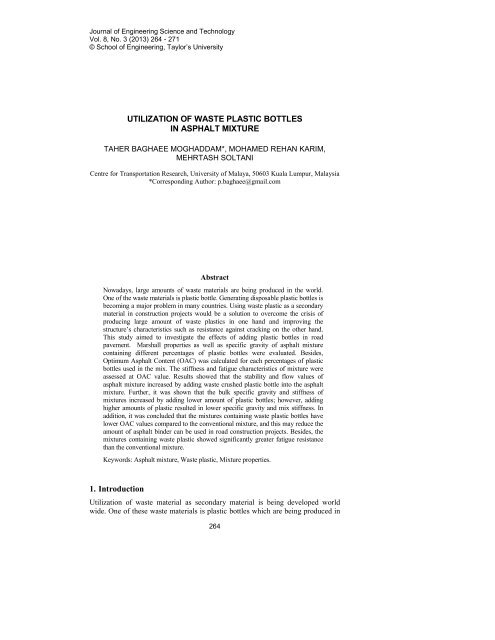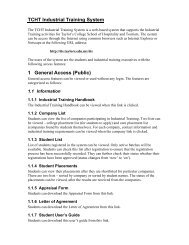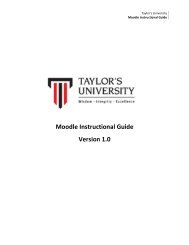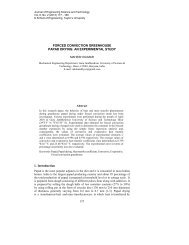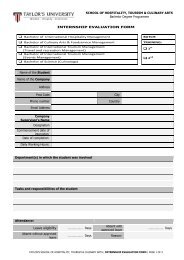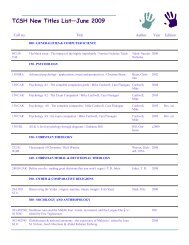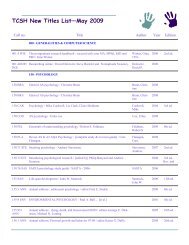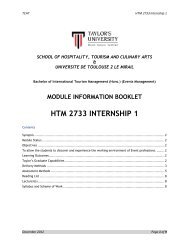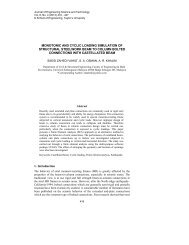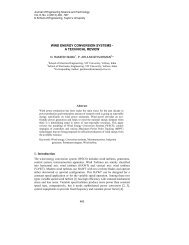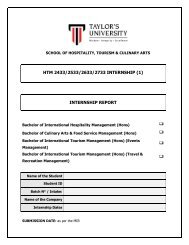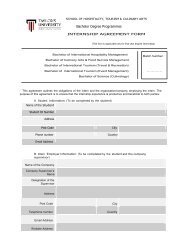Utilization of waste plastic bottles in asphalt mixture - JESTEC
Utilization of waste plastic bottles in asphalt mixture - JESTEC
Utilization of waste plastic bottles in asphalt mixture - JESTEC
You also want an ePaper? Increase the reach of your titles
YUMPU automatically turns print PDFs into web optimized ePapers that Google loves.
Journal <strong>of</strong> Eng<strong>in</strong>eer<strong>in</strong>g Science and Technology<br />
Vol. 8, No. 3 (2013) 264 - 271<br />
© School <strong>of</strong> Eng<strong>in</strong>eer<strong>in</strong>g, Taylor’s University<br />
UTILIZATION OF WASTE PLASTIC BOTTLES<br />
IN ASPHALT MIXTURE<br />
TAHER BAGHAEE MOGHADDAM*, MOHAMED REHAN KARIM,<br />
MEHRTASH SOLTANI<br />
Centre for Transportation Research, University <strong>of</strong> Malaya, 50603 Kuala Lumpur, Malaysia<br />
*Correspond<strong>in</strong>g Author: p.baghaee@gmail.com<br />
Abstract<br />
Nowadays, large amounts <strong>of</strong> <strong>waste</strong> materials are be<strong>in</strong>g produced <strong>in</strong> the world.<br />
One <strong>of</strong> the <strong>waste</strong> materials is <strong>plastic</strong> bottle. Generat<strong>in</strong>g disposable <strong>plastic</strong> <strong>bottles</strong> is<br />
becom<strong>in</strong>g a major problem <strong>in</strong> many countries. Us<strong>in</strong>g <strong>waste</strong> <strong>plastic</strong> as a secondary<br />
material <strong>in</strong> construction projects would be a solution to overcome the crisis <strong>of</strong><br />
produc<strong>in</strong>g large amount <strong>of</strong> <strong>waste</strong> <strong>plastic</strong>s <strong>in</strong> one hand and improv<strong>in</strong>g the<br />
structure’s characteristics such as resistance aga<strong>in</strong>st crack<strong>in</strong>g on the other hand.<br />
This study aimed to <strong>in</strong>vestigate the effects <strong>of</strong> add<strong>in</strong>g <strong>plastic</strong> <strong>bottles</strong> <strong>in</strong> road<br />
pavement. Marshall properties as well as specific gravity <strong>of</strong> <strong>asphalt</strong> <strong>mixture</strong><br />
conta<strong>in</strong><strong>in</strong>g different percentages <strong>of</strong> <strong>plastic</strong> <strong>bottles</strong> were evaluated. Besides,<br />
Optimum Asphalt Content (OAC) was calculated for each percentages <strong>of</strong> <strong>plastic</strong><br />
<strong>bottles</strong> used <strong>in</strong> the mix. The stiffness and fatigue characteristics <strong>of</strong> <strong>mixture</strong> were<br />
assessed at OAC value. Results showed that the stability and flow values <strong>of</strong><br />
<strong>asphalt</strong> <strong>mixture</strong> <strong>in</strong>creased by add<strong>in</strong>g <strong>waste</strong> crushed <strong>plastic</strong> bottle <strong>in</strong>to the <strong>asphalt</strong><br />
<strong>mixture</strong>. Further, it was shown that the bulk specific gravity and stiffness <strong>of</strong><br />
<strong>mixture</strong>s <strong>in</strong>creased by add<strong>in</strong>g lower amount <strong>of</strong> <strong>plastic</strong> <strong>bottles</strong>; however, add<strong>in</strong>g<br />
higher amounts <strong>of</strong> <strong>plastic</strong> resulted <strong>in</strong> lower specific gravity and mix stiffness. In<br />
addition, it was concluded that the <strong>mixture</strong>s conta<strong>in</strong><strong>in</strong>g <strong>waste</strong> <strong>plastic</strong> <strong>bottles</strong> have<br />
lower OAC values compared to the conventional <strong>mixture</strong>, and this may reduce the<br />
amount <strong>of</strong> <strong>asphalt</strong> b<strong>in</strong>der can be used <strong>in</strong> road construction projects. Besides, the<br />
<strong>mixture</strong>s conta<strong>in</strong><strong>in</strong>g <strong>waste</strong> <strong>plastic</strong> showed significantly greater fatigue resistance<br />
than the conventional <strong>mixture</strong>.<br />
Keywords: Asphalt <strong>mixture</strong>, Waste <strong>plastic</strong>, Mixture properties.<br />
1. Introduction<br />
<strong>Utilization</strong> <strong>of</strong> <strong>waste</strong> material as secondary material is be<strong>in</strong>g developed world<br />
wide. One <strong>of</strong> these <strong>waste</strong> materials is <strong>plastic</strong> <strong>bottles</strong> which are be<strong>in</strong>g produced <strong>in</strong><br />
264
<strong>Utilization</strong> <strong>of</strong> Waste Plastic Bottles <strong>in</strong> Asphalt Mixture 265<br />
large amount. In food <strong>in</strong>dustries, <strong>plastic</strong> bottle is mostly made by Polyethylene<br />
Terephthalate (PET), and PET become very popular dur<strong>in</strong>g the last decade<br />
because it is known as safe, durable and good material for packag<strong>in</strong>g [1].<br />
Today, produc<strong>in</strong>g <strong>waste</strong> <strong>plastic</strong> becomes a ma<strong>in</strong> problem <strong>in</strong> many societies<br />
when it can be found almost everywhere specially <strong>in</strong> landfills. Hence, <strong>waste</strong><br />
<strong>plastic</strong> may cause environmental pollution because it is not a biodegradable<br />
material [2]. Thus, it would be reward<strong>in</strong>g if <strong>waste</strong> <strong>plastic</strong>s can be reused, for<br />
<strong>in</strong>stance, <strong>in</strong> projects such as pavement construction as a useful material <strong>in</strong> order to<br />
improve service life <strong>of</strong> road pavement <strong>in</strong> one way and prevent<strong>in</strong>g from<br />
environmental pollution as well.<br />
On the other hand by <strong>in</strong>creas<strong>in</strong>g number and frequency <strong>of</strong> pass<strong>in</strong>g vehicles,<br />
especially heavy vehicles such as trucks and vans which have higher gross weight<br />
than passenger cars, service live <strong>of</strong> road pavement decreases. There are different<br />
ways to improve <strong>asphalt</strong> <strong>mixture</strong> properties. First is construct<strong>in</strong>g road pavement<br />
with higher thickness and second is us<strong>in</strong>g different types <strong>of</strong> additives as modifier<br />
(e.g. different types <strong>of</strong> fibers and polymers) <strong>in</strong> <strong>asphalt</strong> <strong>mixture</strong> [3]. Construct<strong>in</strong>g<br />
high-thickness pavement will cause considerably higher construction cost. Thus,<br />
us<strong>in</strong>g additives might be a better solution to overcome the pavement deterioration<br />
problem. These additives can be used <strong>in</strong> two ways: wet or dry processes. In wet<br />
process the additives will be added <strong>in</strong> <strong>asphalt</strong>, modified <strong>asphalt</strong>, before mix<strong>in</strong>g<br />
with aggregate particles; however, <strong>in</strong> a different procedure, the dry process will<br />
be considered by add<strong>in</strong>g the additive directly <strong>in</strong>to the <strong>mixture</strong> rather than <strong>asphalt</strong>.<br />
In this case, us<strong>in</strong>g <strong>waste</strong> materials as additives would be a better solution <strong>in</strong><br />
order to prevent from additional cost by us<strong>in</strong>g additives <strong>in</strong> <strong>asphalt</strong> <strong>mixture</strong> [4].<br />
Hence, this paper completed the Marshall characteristic and specific gravity <strong>of</strong><br />
<strong>asphalt</strong> <strong>mixture</strong> conta<strong>in</strong><strong>in</strong>g <strong>waste</strong> PET <strong>plastic</strong> <strong>bottles</strong> follow<strong>in</strong>g by obta<strong>in</strong><strong>in</strong>g<br />
optimum <strong>asphalt</strong> contents. Additionally, stiffness and fatigue characteristics <strong>of</strong><br />
<strong>asphalt</strong> <strong>mixture</strong> were evaluated with and without <strong>plastic</strong> modification.<br />
2. Laboratory Investigation<br />
2.1. Materials<br />
80-100 penetration-grade <strong>asphalt</strong> cement was used for this <strong>in</strong>vestigation.<br />
Aggregate particles that were prepared from Kajang quarry <strong>in</strong> Malaysia sieved<br />
and packed accord<strong>in</strong>g to JKR (Malaysian Standard) specification for Stone Mastic<br />
Asphalt (SMA) 14. The gradation limit for aggregate particles can be seen <strong>in</strong><br />
Fig. 1. Further, Table 1 shows the properties <strong>of</strong> the materials used <strong>in</strong> this study.<br />
Waste <strong>plastic</strong> <strong>bottles</strong> that used <strong>in</strong> this study were obta<strong>in</strong>ed from <strong>waste</strong> PET<br />
<strong>bottles</strong>. In order to, provide appropriate <strong>plastic</strong> particles the <strong>bottles</strong> were cut to<br />
small parts then crushed and sieved. The particles which were smaller than 2.36<br />
mm were considered for this <strong>in</strong>vestigation. It should be noticed that different<br />
percentages <strong>of</strong> crushed <strong>plastic</strong> bottled were designated for this study namely: 0%,<br />
0.2%, 0.4%, 0.6%, 0.8% and 1 % by weight <strong>of</strong> aggregate particles.<br />
Journal <strong>of</strong> Eng<strong>in</strong>eer<strong>in</strong>g Science and Technology June 2013, Vol. 8(3)
266 T. B. Moghaddam et al.<br />
Fig. 1. Aggregate Particle Size Distribution (SMA 14).<br />
Table 1. Aggregate and Asphalt Cement Properties.<br />
Properties<br />
Value<br />
Aggregate<br />
Abrasion (%) 19.45<br />
Flak<strong>in</strong>ess Index (%) 2<br />
Elongation Index (%) 11<br />
Bulk specific gravity 2.6<br />
Asphalt cement<br />
Penetration at 25°C (0.1mm) 87<br />
S<strong>of</strong>ten<strong>in</strong>g Po<strong>in</strong>t (°C) 46<br />
Specific gravity 1.03<br />
2.2. Sample preparation and test procedure<br />
Marshall cyl<strong>in</strong>drical samples were fabricated at 160-165˚C and 140˚C <strong>of</strong> mix<strong>in</strong>g<br />
and compaction temperatures, respectively. Different percentages <strong>of</strong> <strong>asphalt</strong><br />
cement were designated (5%, 5.5%, 6%, 6.5% and 7% by weight <strong>of</strong> aggregate<br />
particles) <strong>in</strong> this <strong>in</strong>vestigation.<br />
Marshall stability and flow test were conducted on cyl<strong>in</strong>drical sample<br />
accord<strong>in</strong>g to ASTM D 1559. The specimen is placed <strong>in</strong> the water bath at the<br />
temperature <strong>of</strong> 60°C for 30 m<strong>in</strong> just before commencement <strong>of</strong> the test. Marshall<br />
stability is the maximum load applied at a constant stra<strong>in</strong> (2 <strong>in</strong>. per m<strong>in</strong>ute) which<br />
causes failure. Dur<strong>in</strong>g the stability test the dial gauge is used to measure the<br />
vertical deformation <strong>of</strong> the specimen. Marshall flow value is expressed as the<br />
vertical deformation happens at the failure po<strong>in</strong>t <strong>of</strong> specimen and usually <strong>in</strong> the<br />
units <strong>of</strong> 0.25mm. High flow values generally <strong>in</strong>dicate a <strong>plastic</strong> mix that was<br />
experience permanent deformation under traffic, whereas low flow values may<br />
<strong>in</strong>dicate a mix with higher voids than normal value and <strong>in</strong>sufficient <strong>asphalt</strong> for<br />
durability and one that may experience premature crack<strong>in</strong>g due to mix brittleness<br />
dur<strong>in</strong>g the service life <strong>of</strong> the pavement. In addition, bulk specific gravity <strong>of</strong><br />
compacted <strong>mixture</strong> determ<strong>in</strong>ed <strong>in</strong> accordance with ASTM D 2726.<br />
In this study a total <strong>of</strong> 6 different amounts <strong>of</strong> Optimum Asphalt Contents<br />
(OACs) have been established, at 4% air voids, with regards to six different<br />
percentages <strong>of</strong> <strong>plastic</strong>. OAC must be high enough to provide considerable stability<br />
Journal <strong>of</strong> Eng<strong>in</strong>eer<strong>in</strong>g Science and Technology June 2013, Vol. 8(3)
<strong>Utilization</strong> <strong>of</strong> Waste Plastic Bottles <strong>in</strong> Asphalt Mixture 267<br />
and durability. It also should be low enough to prevent b<strong>in</strong>der dra<strong>in</strong>-down. Marshall<br />
mix design procedure is the most common way to optimize <strong>asphalt</strong> content value.<br />
Table 2 shows the requirement for stone mastic <strong>asphalt</strong> <strong>mixture</strong>s at OAC [5].<br />
Table 2. Requirement for Stone Mastic Asphalt<br />
Mixtures at Optimum Asphalt Content.<br />
Property Criteria [6]<br />
VIM a 3-4%<br />
VMA b<br />
17% m<strong>in</strong>.<br />
Asphalt content 6% m<strong>in</strong>.<br />
Compaction effort 50 Blows<br />
Dra<strong>in</strong> down 3% max.<br />
a b Void <strong>in</strong> mix, Void <strong>in</strong> m<strong>in</strong>eral aggregate<br />
Stiffness modulus and <strong>in</strong>direct tensile fatigue test were designated for<br />
<strong>mixture</strong>s at OAC to obta<strong>in</strong> stiffness and fatigue characteristics <strong>of</strong> <strong>asphalt</strong> mixes<br />
accord<strong>in</strong>g to AASHTO TP31 and EN 12697, respectively. The tests were<br />
conducted at three different stress levels (250, 350 and 450 kPa), which are near<br />
stress values that usually road pavement is designed, and temperature <strong>of</strong> 20˚C.<br />
Fatigue life <strong>of</strong> <strong>asphalt</strong> mixes were considered at the cycles where the sample fails<br />
or vertical deformation reaches to the maximum value <strong>of</strong> 9 mm. Totally, n<strong>in</strong>ety<br />
samples were fabricated for <strong>asphalt</strong> mix design and fifty four samples for the<br />
stiffness and fatigue tests.<br />
3. Results and Discussion<br />
3.1. Marshall stability and flow<br />
As can be seen <strong>in</strong> Fig. 2, <strong>in</strong> many cases, Marshal stability (MS) value <strong>in</strong>creases by<br />
add<strong>in</strong>g <strong>waste</strong> <strong>plastic</strong> <strong>bottles</strong> <strong>in</strong>to <strong>asphalt</strong> <strong>mixture</strong>s up to 0.6 % <strong>plastic</strong>; however, at<br />
higher <strong>plastic</strong> contents MS decreases. It is also noted that MS value decreases at<br />
higher <strong>asphalt</strong> amount. This result may <strong>in</strong>dicate that better adhesion provided<br />
between <strong>asphalt</strong> b<strong>in</strong>der and aggregate particles by add<strong>in</strong>g <strong>waste</strong> <strong>plastic</strong> bottle.<br />
Fig. 2. MS vs. Plastic Bottle Contents.<br />
Journal <strong>of</strong> Eng<strong>in</strong>eer<strong>in</strong>g Science and Technology June 2013, Vol. 8(3)
268 T. B. Moghaddam et al.<br />
Figure 3 shows that Marshall flow (MF) <strong>in</strong>creases by add<strong>in</strong>g <strong>waste</strong> <strong>plastic</strong><br />
<strong>bottles</strong>, and that specimen constructed at higher <strong>asphalt</strong> content showed higher<br />
MF value. Thus, maximum MF value observed at the specimen made at 1% and<br />
7% <strong>plastic</strong> and <strong>asphalt</strong> content, respectively. Obta<strong>in</strong>ed results may <strong>in</strong>dicate that<br />
<strong>in</strong>ternal friction <strong>of</strong> <strong>mixture</strong> would be decreased by add<strong>in</strong>g <strong>plastic</strong> <strong>in</strong>to <strong>mixture</strong><br />
which eventually results <strong>in</strong> higher flow. It is good to notice that high density<br />
polyethylene (HDPE), which is another type <strong>of</strong> <strong>plastic</strong>, had the same results on<br />
<strong>mixture</strong> flow [7].<br />
Fig. 3. MF vs. Plastic Bottle Contents.<br />
3.2. Bulk specific gravity<br />
Bulk specific gravity (BSG) <strong>of</strong> compacted <strong>mixture</strong>s is calculated us<strong>in</strong>g Equation<br />
1, and the results are shown <strong>in</strong> Fig. 4. It is shown that BSG <strong>in</strong>itiate with an<br />
<strong>in</strong>creas<strong>in</strong>g trend by add<strong>in</strong>g <strong>plastic</strong> <strong>bottles</strong> then the trend decreased at higher<br />
<strong>plastic</strong> contents. Further, <strong>mixture</strong>s manufactured at higher <strong>asphalt</strong> contents<br />
showed to have higher BSG. It is good to notice the highest BSG is for the<br />
<strong>mixture</strong>s with 0.4% and 7% <strong>plastic</strong> bottle and <strong>asphalt</strong> content, respectively.<br />
Fig. 4. BSG vs. Plastic Bottle Contents.<br />
Journal <strong>of</strong> Eng<strong>in</strong>eer<strong>in</strong>g Science and Technology June 2013, Vol. 8(3)
<strong>Utilization</strong> <strong>of</strong> Waste Plastic Bottles <strong>in</strong> Asphalt Mixture 269<br />
3.3. Optimum <strong>asphalt</strong> content<br />
For stone mastic <strong>asphalt</strong> <strong>mixture</strong>s optimum <strong>asphalt</strong> content (OAC) was calculated<br />
to achieve 4% air voids <strong>in</strong> mix. Obta<strong>in</strong>ed results are depicted <strong>in</strong> Fig. 5. As it is<br />
shown, OAC value decreased by add<strong>in</strong>g <strong>plastic</strong> bottle <strong>in</strong>to <strong>asphalt</strong> <strong>mixture</strong>s (up to<br />
0.6%), then rose by add<strong>in</strong>g higher percentages <strong>of</strong> <strong>plastic</strong>. It is apparent from the<br />
results that lower <strong>asphalt</strong> b<strong>in</strong>der is needed to achieve the proper air voids <strong>in</strong> mix<br />
by add<strong>in</strong>g lower amount <strong>of</strong> PET which can be due to fill<strong>in</strong>g pores by PET<br />
particles <strong>in</strong> <strong>mixture</strong>; although at higher PET content more PET surface should be<br />
coated by <strong>asphalt</strong> b<strong>in</strong>der which results <strong>in</strong> higher OAC value. Besides, elastic<br />
deformation <strong>of</strong> PET particles under compaction effort may be considered as<br />
second reason to cause higher OAC.<br />
Fig. 5. OAC vs. Plastic Bottle Contents.<br />
3.4. Stiffness<br />
As depicted <strong>in</strong> Fig. 6, mixes <strong>in</strong>clud<strong>in</strong>g <strong>plastic</strong> <strong>bottles</strong> showed to have higher<br />
stiffness at lower amount <strong>of</strong> <strong>plastic</strong> bottle; however, by contrast, add<strong>in</strong>g more<br />
<strong>plastic</strong> makes mixes less stiff. It can be concluded from the results that <strong>mixture</strong><br />
conta<strong>in</strong><strong>in</strong>g higher amount <strong>of</strong> <strong>plastic</strong> has more recoverable displacement under<br />
cyclic loads compared to conventional <strong>mixture</strong>.<br />
Fig. 6. Stiffness vs. Plastic.<br />
Journal <strong>of</strong> Eng<strong>in</strong>eer<strong>in</strong>g Science and Technology June 2013, Vol. 8(3)
270 T. B. Moghaddam et al.<br />
3.5. Fatigue<br />
As it is shown <strong>in</strong> Fig. 7, fatigue life <strong>of</strong> <strong>asphalt</strong> mixes <strong>in</strong>creases dramatically by<br />
add<strong>in</strong>g <strong>plastic</strong> particles. It is illustrated that mixes with 1% <strong>plastic</strong> shows the highest<br />
fatigue lives which are more than doubled at lower stress levels (250 kPa and 350<br />
kPa). On the contrary, <strong>in</strong> all stress levels, the mixes without <strong>plastic</strong> give the lowest<br />
value. The results might be because <strong>of</strong> improvement <strong>in</strong> <strong>mixture</strong> flexibility, as<br />
discussed <strong>in</strong> previous section [4]. In fact, PET particles would not melt due to<br />
higher melt<strong>in</strong>g po<strong>in</strong>t <strong>of</strong> PET and still exist as partially rigid materials <strong>in</strong> <strong>mixture</strong>,<br />
thus can improve the flexibility <strong>of</strong> <strong>mixture</strong>. Hence, because <strong>mixture</strong>’s flexibility is<br />
improved by add<strong>in</strong>g <strong>plastic</strong> particles, crack creation and propagation <strong>in</strong> <strong>asphalt</strong><br />
<strong>mixture</strong> would be postponed which eventually results <strong>in</strong> higher fatigue life.<br />
Fig. 7. Fatigue Life vs. Plastic.<br />
4. Conclusions<br />
This paper discusses about basic properties as well as mix design <strong>of</strong> SMA <strong>mixture</strong><br />
conta<strong>in</strong><strong>in</strong>g <strong>waste</strong> <strong>plastic</strong> bottle particles, and results are summarized as follows:<br />
• Mixtures conta<strong>in</strong><strong>in</strong>g <strong>waste</strong> <strong>plastic</strong> <strong>bottles</strong> had more stability values compared to<br />
conventional <strong>mixture</strong> and the stability trends <strong>in</strong>itially <strong>in</strong>creased by add<strong>in</strong>g<br />
lower percentages <strong>of</strong> <strong>plastic</strong> <strong>bottles</strong> and decreased at higher amount <strong>of</strong> <strong>plastic</strong>.<br />
• Add<strong>in</strong>g higher amount <strong>of</strong> <strong>plastic</strong> <strong>bottles</strong> resulted <strong>in</strong> higher flow value.<br />
• BSG rose at lower amount <strong>of</strong> <strong>plastic</strong> <strong>bottles</strong>, and then decreased at higher<br />
percentages <strong>of</strong> <strong>plastic</strong>.<br />
• Plastic-re<strong>in</strong>forced <strong>mixture</strong>s showed to have lower OAC value.<br />
• Stiffness <strong>of</strong> <strong>asphalt</strong> mixes with lower <strong>plastic</strong> content (0.2%) <strong>in</strong>itially <strong>in</strong>creases;<br />
however, by a big contrast, stiffness decreases at higher amount <strong>of</strong> <strong>plastic</strong><br />
contents. Besides, fatigue life <strong>of</strong> <strong>asphalt</strong> <strong>mixture</strong>s with <strong>plastic</strong> bottle was longer<br />
<strong>in</strong> comparison with the <strong>mixture</strong>s without <strong>plastic</strong>. These results may <strong>in</strong>dicate<br />
that the flexibility <strong>of</strong> mixes was improved, and by improv<strong>in</strong>g the flexibility<br />
crack creation and propagation <strong>in</strong>to <strong>asphalt</strong> mixes would be postponed.<br />
Journal <strong>of</strong> Eng<strong>in</strong>eer<strong>in</strong>g Science and Technology June 2013, Vol. 8(3)
<strong>Utilization</strong> <strong>of</strong> Waste Plastic Bottles <strong>in</strong> Asphalt Mixture 271<br />
References<br />
1. Shi, B.; Liang, H.; Kuhn, T.B.; and Duffy, L.K. (2006). Surface properties <strong>of</strong><br />
cell-treated polyethylene terephthalate. American Journal <strong>of</strong> Biochemistry<br />
and Biotechnology, 2(4), 170-174.<br />
2. Siddiqui, M.N. (2009). Conversion <strong>of</strong> hazardous <strong>plastic</strong> <strong>waste</strong>s <strong>in</strong>to useful<br />
chemical products. Journal <strong>of</strong> Hazardous Materials, 167(1-3), 728-735.<br />
3. Moghaddam, T.B.; Karim, M.R.; and Mahrez, A. (2011). A review on fatigue<br />
and rutt<strong>in</strong>g performance <strong>of</strong> <strong>asphalt</strong> mixes. Scientific Research and Essays,<br />
6(4), 670-682.<br />
4. Moghaddam, T.B.; Karim, M.R. and Syammaun, T. (2012). Dynamic<br />
properties <strong>of</strong> stone mastic <strong>asphalt</strong> <strong>mixture</strong>s conta<strong>in</strong><strong>in</strong>g <strong>waste</strong> <strong>plastic</strong> <strong>bottles</strong>.<br />
Construction and Build<strong>in</strong>g Materials, 34, 236-242.<br />
5. Asi, I.M. (2006). Laboratory comparison study for the use <strong>of</strong> stone matrix<br />
<strong>asphalt</strong> <strong>in</strong> hot weather climates.Construction and Build<strong>in</strong>g Materials, 20(10),<br />
982-989.<br />
6. NAPA. (2002). Design<strong>in</strong>g and construct<strong>in</strong>g SMA <strong>mixture</strong>s: State-<strong>of</strong>-thepractice.<br />
National Asphalt Pavement Association, Quality Improvement<br />
Series 122.<br />
7. Hınıslıoğlu, S.; and Ağar, E. (2004). Use <strong>of</strong> <strong>waste</strong> high density<br />
polyethylene as bitumen modifier <strong>in</strong> <strong>asphalt</strong> concrete mix. Materials<br />
Letters, 58(3-4), 267-271.<br />
Journal <strong>of</strong> Eng<strong>in</strong>eer<strong>in</strong>g Science and Technology June 2013, Vol. 8(3)


